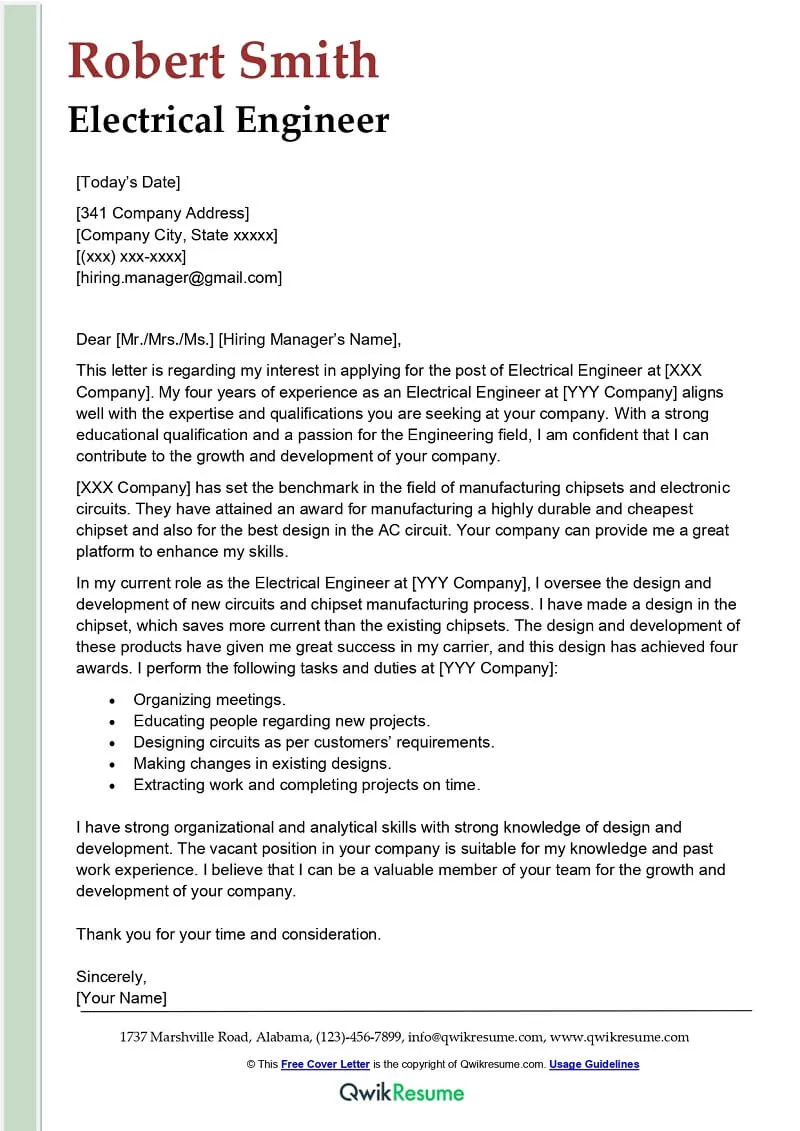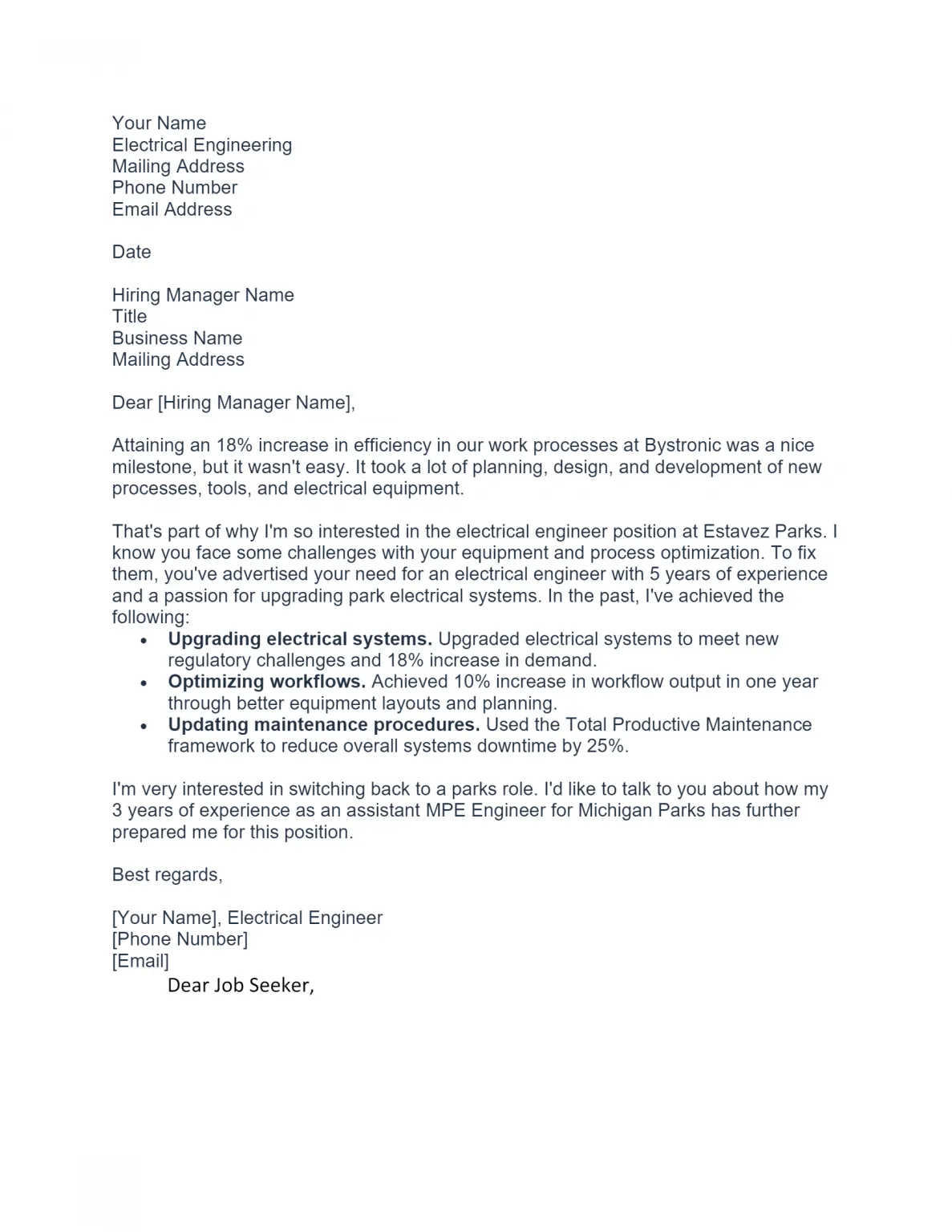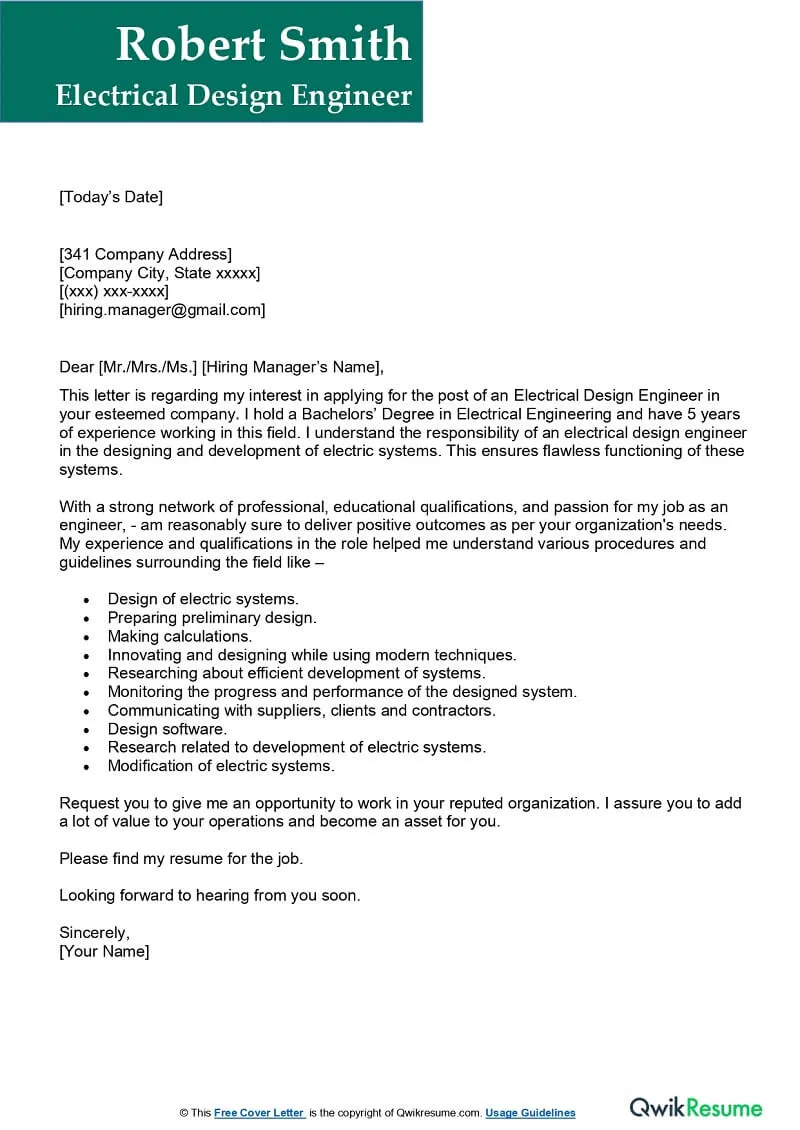Cover Letter for Electrical Engineer [Top 7 Tips]
Crafting a compelling cover letter is crucial for electrical engineers aiming to make a strong first impression. A well-written cover letter not only introduces you to a potential employer but also highlights your key skills, experiences, and achievements. It’s your opportunity to demonstrate how your qualifications align with the job requirements and showcase your enthusiasm for the role. This guide provides seven essential tips to help you create a cover letter that stands out and increases your chances of landing an interview. By following these tips, you can effectively communicate your value and make a lasting positive impact on potential employers. Remember that each cover letter should be tailored to the specific job and company to maximize its effectiveness. Preparing a good cover letter is time-consuming and takes effort, but it’s well worth it to gain the attention of the right people at the companies you are interested in.
Highlighting Your Skills & Experience
Your cover letter is the ideal place to showcase the skills and experience that make you a strong candidate. Start by identifying the key requirements listed in the job description and then explain how your qualifications align with those needs. Provide concrete examples of how you’ve utilized your skills in previous roles or projects. Detail specific technical skills such as proficiency in relevant software (e.g., AutoCAD, MATLAB, or specific simulation tools) and any experience you have with designing, testing, or implementing electrical systems. Moreover, highlight any soft skills like problem-solving, teamwork, and communication, as these are also important for electrical engineers. The goal is to demonstrate to the hiring manager that you possess the blend of technical expertise and interpersonal abilities necessary to excel in the role. Make sure to use keywords from the job description to show that you are a good fit for the position.
Quantify Your Achievements

Instead of merely listing your responsibilities, quantify your achievements to demonstrate your impact. Use numbers and data to illustrate your accomplishments whenever possible. For example, instead of writing “Managed electrical projects,” write “Managed electrical projects, delivering them 15% under budget and 10 days ahead of schedule.” Mention specific cost savings, efficiency improvements, or performance enhancements you achieved in your previous roles. This shows potential employers the tangible value you can bring to their organization. Examples of other data points include the number of projects completed, the size of the teams you have managed, or the percentage by which you improved a specific process. By quantifying your achievements, you make a stronger case for your abilities and make it easier for the recruiter to imagine how you would perform at their company. This will greatly increase your chances of getting an interview.
Showcasing Relevant Projects
Provide detailed descriptions of the projects you have undertaken that are relevant to the target job. Focus on projects where you were directly involved in the design, implementation, or testing of electrical systems. Briefly explain the project’s objectives, your role, and the technologies you utilized. Emphasize any unique challenges you overcame and the innovative solutions you developed. If possible, mention the outcomes of the project, such as improved efficiency, cost savings, or successful completion. Highlighting relevant projects gives the employer a better understanding of your capabilities and how you would apply them in a new role. When detailing your projects, make sure to use action verbs to describe your role, such as “designed,” “implemented,” “tested,” or “managed.” Be specific about your contributions and the results you achieved.
Tailoring Your Cover Letter
Generic cover letters rarely make a positive impact. To maximize your chances of success, customize each cover letter for the specific job and company. Research the company’s values, mission, and recent projects to show genuine interest. Address the hiring manager by name if possible and refer to specific aspects of the job description. Explain why you are interested in the particular role and why you believe your skills and experience are a good match. Mention any specific initiatives or projects the company is involved in that appeal to you. Demonstrate your understanding of the company’s needs and how you can contribute to its goals. This level of personalization proves that you are not sending a mass application but have taken the time to understand the opportunity and are genuinely enthusiastic about the prospect.
Addressing the Employer’s Needs

A successful cover letter addresses the employer’s needs by demonstrating how you can solve their problems or help them achieve their goals. Carefully review the job description to identify the key skills and qualifications the employer is seeking. In your cover letter, specifically address these needs by explaining how your experience and abilities align with them. Show how your previous roles have prepared you to meet the challenges of the new position. Use the language of the job description and emphasize your ability to contribute to the company’s success. Give the reader a clear picture of how you can add value. By demonstrating that you understand the employer’s needs, you’ll significantly increase your chances of securing an interview.
Formatting and Structure for Impact
The formatting and structure of your cover letter are as important as its content. Use a professional font, such as Times New Roman or Arial, and maintain a consistent font size throughout. Keep the letter concise and easy to read, typically no more than one page. Use clear headings and bullet points to organize information and make it scannable. Ensure that your letter has a logical flow, with a clear introduction, body paragraphs that highlight your key skills and experiences, and a strong closing. Proofread for any typos or grammatical errors, as these can undermine your credibility. Make sure to include your contact information at the top of the letter. Use white space effectively to make the letter visually appealing and easy to read. A well-formatted cover letter demonstrates professionalism and attention to detail, qualities that are highly valued in an electrical engineer.
Proofreading and Editing for Perfection
Before sending your cover letter, take the time to proofread and edit it carefully. Typos, grammatical errors, and inconsistencies can create a negative impression, potentially leading to your application being rejected. Proofread your letter multiple times, and consider asking a friend or colleague to review it as well. Ensure that the formatting is consistent and that all information is accurate. Check that the tone is professional and that the letter is free of jargon or overly technical language. Paying close attention to detail in the editing phase shows that you are meticulous and that you can produce professional and effective written communications. By meticulously proofreading your cover letter, you present yourself as a candidate who values quality, accuracy, and attention to detail.
In conclusion, writing a compelling cover letter is a critical step in the job application process for electrical engineers. By implementing these seven tips – highlighting your skills and experience, quantifying your achievements, showcasing relevant projects, tailoring your letter, addressing the employer’s needs, using effective formatting and structure, and proofreading meticulously – you can significantly increase your chances of securing an interview and advancing your career. Remember, a well-crafted cover letter is your opportunity to make a strong first impression and demonstrate your suitability for the role. Good luck with your job search!
